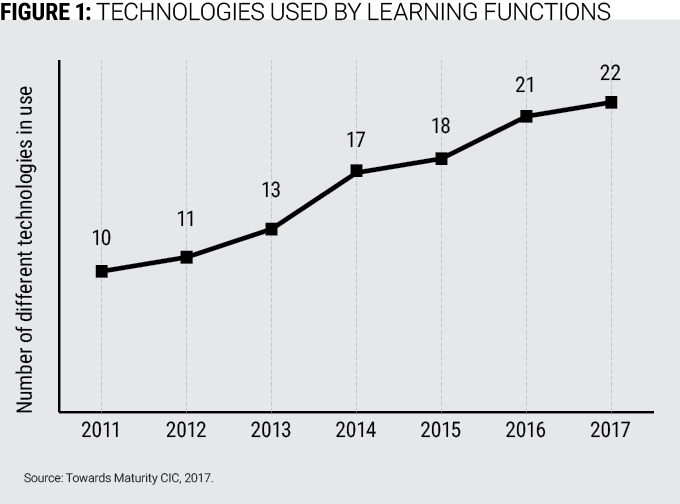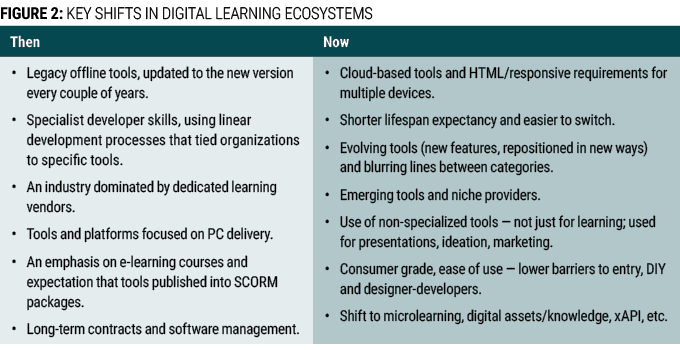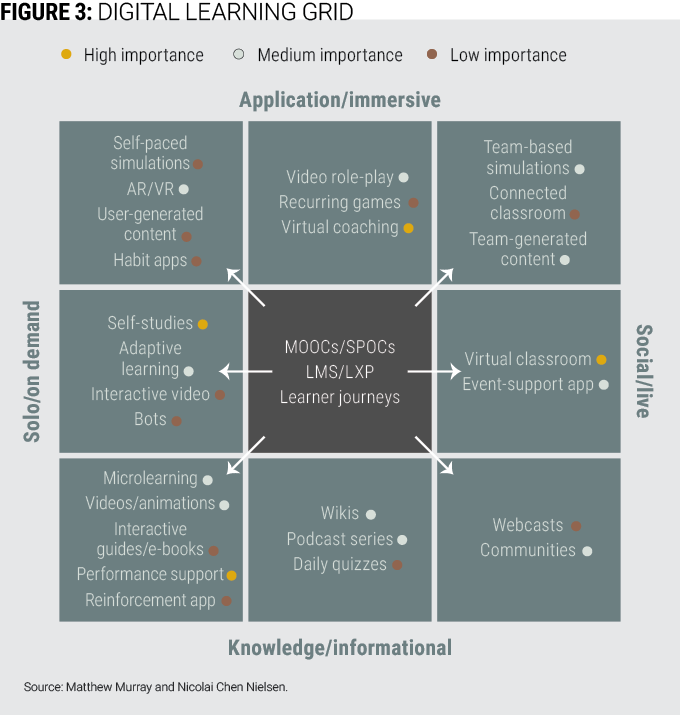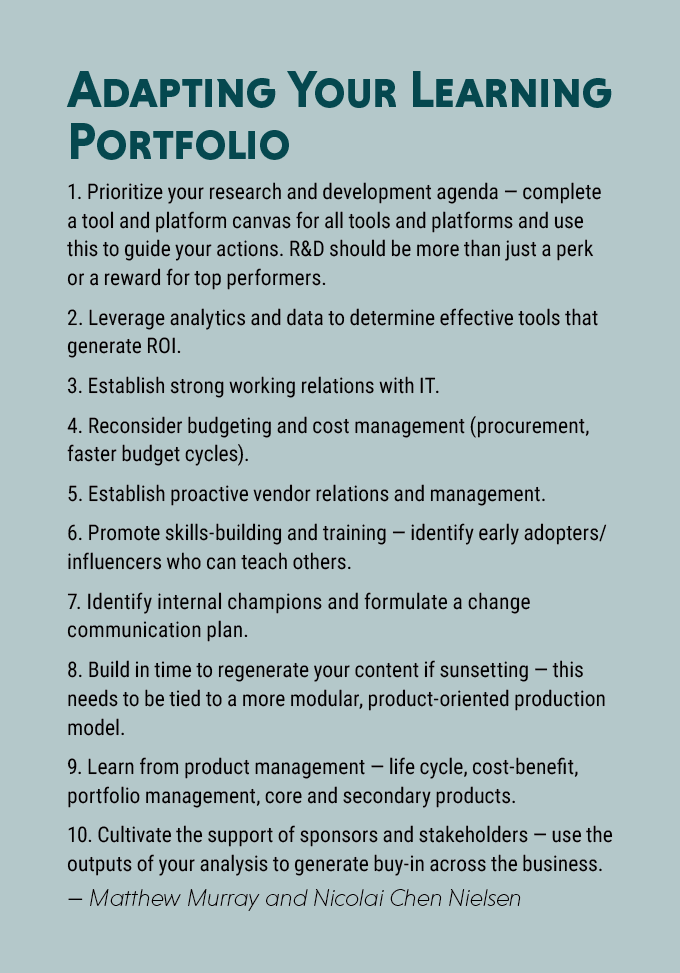Do you have moments when you realize you don’t have a clear grip on your digital learning ecosystem? For example, when you speak with a potential vendor, only to find out they’ve already run an event with a business group in another region? Or when a business partner points at a popular app on their phone asking, “Why can’t we do this?” and you don’t have a good response? Or when you see a line item for licenses in your budget and you have to ask your production manager what it’s for?
It can be challenging for learning leaders to actively manage and tell a convincing story about the digital tools and platforms we have in our portfolio. We tend to focus on one or two larger systems (learning management systems or learning experience platforms), often at the expense of our complete range of tools and platforms.
Consequently, we don’t have an integrated road map or comprehensive point of view on how to create world-class learning experiences, enable our teams to rapidly build and iterate content and courses, and rigorously measure outcomes. And that means we don’t have the right ecosystem in place to enable and track the behavior and mindset shifts needed to achieve our employees’ performance goals and execute on our business strategy.
Typically, it’s a story of haphazard adoption, periodic bursts of innovation and lack of a clear digital learning strategy. Common reasons could be that:
- Tools are introduced for a single program and then organically spread to other programs without clear guidance on the potential impact to behaviors and performance.
- Purchasing decisions are based on leftover budget or are scattered across different groups.
- The existing skill set of designers and developers encourages inertia and determines which production and delivery services are performed internally or externally.
- Selection processes are driven by a “wow” factor — what is seen at an expo or because a competitor L&D function is doing something with a certain platform.
- Tool and platform management is decentralized and fragmented, with no clear accountability or internal champions.
- Learning functions become dependent on legacy homegrown apps and platforms, which are inherited and difficult to retire.
One financial services client we partnered with had an energetic innovation team that would successfully pilot new tools and platforms — but struggled to achieve broader adoption because it was too removed from the broader business needs the learning function was serving. The innovation agenda was not strategically connected to long-term value planning for the learning team. An uncoordinated approach like this is increasingly a problem because the authoring and delivery tools we use impact our learning solutions, our learning organization and processes, and our ability to generate meaningful reporting and analytics.
 As our approaches and delivery options become increasingly digitized, we should be treating these choices as a priority, and as an enabler to achieve and maintain business impact. A large pharmaceutical client we worked with had more than 20 disparate LMSs globally, leading to confusion among learners and costing millions of dollars in maintenance a year. Using outdated or suboptimal digital tools not only negatively affects the effectiveness of learning — and by extension the business value at stake — but also can impact your organization’s ability to successfully recruit and retain top talent.
As our approaches and delivery options become increasingly digitized, we should be treating these choices as a priority, and as an enabler to achieve and maintain business impact. A large pharmaceutical client we worked with had more than 20 disparate LMSs globally, leading to confusion among learners and costing millions of dollars in maintenance a year. Using outdated or suboptimal digital tools not only negatively affects the effectiveness of learning — and by extension the business value at stake — but also can impact your organization’s ability to successfully recruit and retain top talent.
Part of the issue is that we might not have a good way of describing our tools and platforms and explaining our selection and use decisions. We gravitate toward highly technical differentiations or buzzwords like gamification or microlearning. Our categorizations can be blurry. The challenge is exacerbated by the growing volume and complexity of our tools and delivery platforms. As Figure 1 indicates, the number of technologies learning functions use has been rising steadily over the past few years.
Additionally, the increasingly dynamic digital learning landscape has rapidly evolved and is fundamentally different today than just five years ago. Figure 2 outlines some of the key shifts we have noticed in digital learning ecosystems.

Given these developments, it’s critical to have a digital learning production strategy and perform a periodic ecosystem analysis. The lack of a clear strategy can contribute to the perception from the business that L&D is not capable of meeting the organization’s reskilling, transformation and development needs.
Establishing a Digital Learning Strategy
We find that a great digital learning strategy has a number of key characteristics. First, it is proactive and specific, driven by your organization’s current and future requirements. Second, it is focused on learner needs and fit for purpose to serve the continuous omnilearning expectations of your organization’s people. Third, it should be founded on the generation of meaningful learning data and the analysis of impact metrics. And fourth, it is a key component of your team’s internal brand and innovation agenda.
A clear digital learning strategy has numerous benefits. It establishes a point of view for the business on the criteria and rationale for the adoption and retirement of new technologies. Advancing your organization’s digital transformation, it aligns your priorities and decisions to your broader business objectives. The strategy ensures consistency and avoids redundancy across learning teams. And it achieves efficiencies from skills building, templates and production processes.
As a starting point for developing a perspective on your digital learning ecosystem, ask yourself a few fundamental questions: Is your ecosystem the right size? Do you have too few tools or too many? Is it balanced? Do the tools you have fit your learning needs? How do you make decisions on adding and removing? What’s your process for managing the platform life cycles?
Finally, how do you support it? What skills are required? What budget? What integration questions?
If you’re struggling to answer these questions, it could mean you don’t have alignment or a clearly communicated strategy. We propose a practical approach to get started, focusing on your desired future state (not your current state) to determine what authoring tools and delivery platforms should be in your ecosystem. This is a two-step process: (1) Map your learning needs on a digital learning grid. (2) Determine the “importance index” for each tool and platform using data-driven criteria to assess their relative significance for your learning needs.
Step 1: Map Your Learning Needs
A digital learning grid (see Figure 3) maps tools, modalities and platforms with a focus on the learning experience, not from the perspective of the learning function’s needs or features of the technology. (Ignore the importance rankings for now — we will get to that in a bit.)

The vertical axis ranges from presentational approaches at the bottom to application and immersion at the top. Although categorizing learning technologies according to learning levels can be blurry, this axis roughly corresponds to Bloom’s Taxonomy. Tools and platforms toward the bottom are generally better suited to knowledge transfer; those at the top are generally better suited to experiential learning and synthesis. Learning by doing is achieved primarily through the tools and platforms at the top; learning in the flow of work is achieved principally through approaches at the bottom.
The horizontal axis ranges from solo and asynchronous learning on the left to social and synchronous learning on the right. The tools on the left are generally well suited to personalization, anytime/anywhere access, and just-in-time/just-enough learning. Platforms toward the right benefit from live, group-based sharing and interaction. In the middle you have intermittent learning or learning from others over time.
The grid is not an evaluative framework — top right is no better nor worse than bottom left. The objective here is to identify which learning needs should be covered by your digital learning production and delivery technologies. There will be exceptions and the mapping of the tools and platforms is not mutually exclusive or collectively exhaustive. The positioning of LMSs, LXPs and other systems in the center box is to represent that you ideally need an integrating portal/single point of entry to connect the various elements of the learning journey experiences.
Step 2: Determine the Importance Index for Each Tool and Platform
Once you have the grid in place, you can determine the relative importance of each tool and platform, based on your organization’s learning priorities. Undertake an assessment of what’s important to your organization’s current and future (next 24 months) learning needs, driven by the skills, behaviors and mindset shifts necessary to achieve your business results. The assessment can range from simple to complex. The more data points and perspectives you incorporate, the stronger the analysis.
Remember, this is not an assessment of your current level of use. Instead, this is an objective evaluation of which tools and platforms should be used to best support your learning requirements. A simple approach is to assign high/medium/low levels of importance to each tool and platform category (e.g., gold/silver/bronze indicators). A deeper analysis could involve a criteria-based approach to determining relative importance (through a thorough analysis of learning needs across your programs and best fit for purpose).
We recommend you factor in a number of considerations: volume and scalability, significance (you might have a niche, high-profile program with specific digital needs), your organization’s learning culture, evaluation data from existing programs, your vision for your future learning approach (e.g., you wish to move to more experiential formats), and other relevant data points.
Exercise discipline when assigning an importance index. Larger, more diverse learning environments will likely have more high/medium allocations than smaller, more homogeneous situations. But if you don’t have differentiation across the categories, then you aren’t being rigorous. For instance, some businesses have little need for augmented reality since their workforce stares at a screen all day (holding a phone up in front of a monitor is of limited value when you can integrate informational layers directly on the monitor screen). Some organizations are physically collocated in one place and don’t require virtual classroom deliveries. An example output is provided in Figure 3.
It’s important to note: The process of completing this exercise can be very revealing. You can build alignment by running it as a team activity. The exercise can generate powerful dialogue and raise divergences you may not have realized existed. Since it might surface latent disconnects, be on the lookout for defensiveness and encourage participants to keep the conversation data-driven. Suggest that they regard it as an opportunity to clarify and update the team’s value proposition. For instance, it might require your virtual classroom team to more clearly articulate the value of their service from a learning needs perspective. It can be a positive way to break down legacy mindsets (“We’ve always done it this way!”) and keep the focus on where the organization should be helping to drive business success. Involvement in the process ensures buy-in across the team around the ecosystem strategy.
 Once you have your importance indexes identified, you can then assess the degree of alignment between your desired state and your current state of reality. Closing the gap between the two will become the basis of your action plan.
Once you have your importance indexes identified, you can then assess the degree of alignment between your desired state and your current state of reality. Closing the gap between the two will become the basis of your action plan.
This plan could require you to change the conversations you have with SMEs and business partners and actively managing your portfolio of tools and platforms. You may need to address redundancy or an overabundance of tools in a lower-impact area. You might want to rebalance your ecosystem to better address high-priority areas. See sidebar for practical tips to adapt your learning portfolio.
The Bottom Line
Building digital success is one of the top critical factors in establishing a high-performing learning culture, according to Towards Maturity’s 2019 annual research report, “The Transformation Journey.” A European financial services organization we worked with was able to achieve a 17 percent increase in learner satisfaction and greater than 20 percent reduction in costs by transforming its curriculum to a largely digital, media-enabled learning approach. Undertaking a strategic assessment and putting in place new approaches will enable you to shift the narrative around your digital learning production and delivery. Doing so can not only reduce L&D expenditures and improve efficiency, but have tangible impact on the learning experience, degree of learning and business impact.















